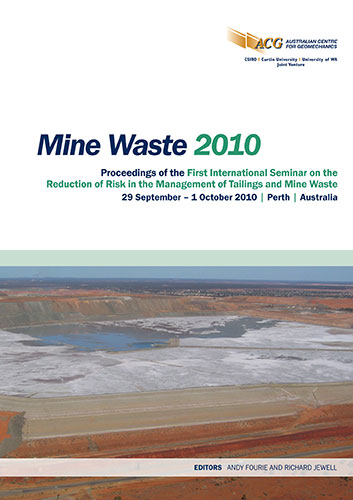Co-disposal techniques that may mitigate risks associated with storage and management of potentially acid generating wastes

|
Authors: Gowan, M; Lee, M; Williams, DJ |
DOI https://doi.org/10.36487/ACG_rep/1008_33_Gowan
Cite As:
Gowan, M, Lee, M & Williams, DJ 2010, 'Co-disposal techniques that may mitigate risks associated with storage and management of potentially acid generating wastes', in R Jewell & AB Fourie (eds), Mine Waste 2010: Proceedings of the First International Seminar on the Reduction of Risk in the Management of Tailings and Mine Waste, Australian Centre for Geomechanics, Perth, pp. 389-404, https://doi.org/10.36487/ACG_rep/1008_33_Gowan
Abstract:
A mine tailings disposal facility (TSF) remains a major source of risk for a mining operation. It is in reality the only structure on the mine, together with mine waste dumps, that has to “last forever” after the mining operation ceases. While the normal method of tailings disposal into a TSF is well understood and widely practiced, the alternative methods available using co-disposal may provide significant advantages for mining operations with particular issues or problems. Constraints on mining such as reduced or limited water supply, the need to recycle more water, higher water quality discharge requirements and post closure risks, are encouraging mine planners to consider alternatives to the traditional methods of mine waste management. One of the options available to planners and operators is the co-disposal of tailings and waste rock, particularly if potentially acid forming, for safer storage. In this paper, the general types of mine waste storage facilities (e.g. valley, paddock and in-pit storages) and the nature of tailings and waste rock are described, and co-disposal (and co-mingling) techniques to reduce the risks associated with the storage and management of wastes are discussed. The potential benefits of these techniques during operation and mine closure are described.
© Copyright 2026, Australian Centre for Geomechanics (ACG), The University of Western Australia. All rights reserved.
View copyright/legal information
Please direct any queries or error reports to repository-acg@uwa.edu.au
View copyright/legal information
Please direct any queries or error reports to repository-acg@uwa.edu.au